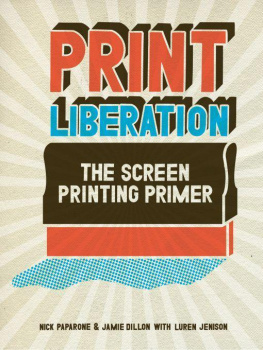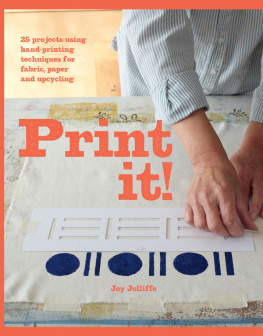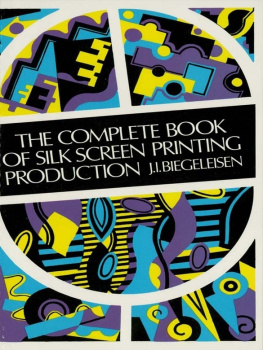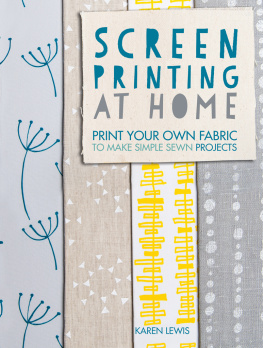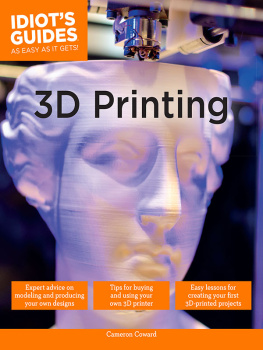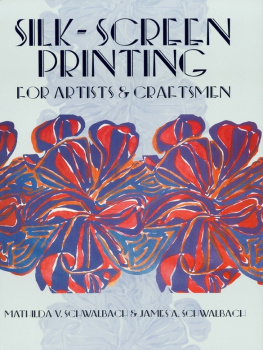Table of Contents
Print Liberation. Copyright 2008 by Nick Paparone, Jamie Dillon and Luren Jenison. Manufactured in China. All rights reserved. The patterns and drawings in this book are for personal use of the reader. By permission of the author and publisher, they may be used by the reader, but under no circumstances may they be resold or republished. It is permissible for the purchaser to make the projects contained herein solely for personal use. No other part of this book may be reproduced in any form or by any electronic or mechanical means, including information storage and retrieval systems, without permission in writing from the publisher, except by a reviewer, who may quote a brief passage in review. Published by North Light Books, an imprint of F+W Publications, Inc., 4700 East Galbraith Road, Cincinnati, Ohio 45236. (800) 289-0963. First edition.
12 11 10 09 08 5 4 3 2 1
Library of Congress Cataloging-in-Publication Data
Paparone, Nick.
Print liberation : the screen printing primer / by Nick Paparone and Jamie Dillon, with Luren Jenison. -- 1st ed. p. cm.
ISBN-13: 978-1-60061-072-1 (alk. paper)
1. Screen process printing. I. Dillon, Jamie. II. Jenison, Luren. III. Title.
TT273.P36 2008
686.2316--dc22
2008000822
Distributed in Canada by Fraser Direct
100 Armstrong Avenue
Georgetown, ON, Canada L7G 5S4
Tel: (905) 877-4411
Distributed in the U.K. and Europe by David & Charles
Brunel House, Newton Abbot, Devon, TQ12 4PU, England
Tel: (+44) 1626 323200, Fax: (+44) 1626 323319
E-mail: postmaster@davidandcharles.co.uk
Distributed in Australia by Capricorn Link
P.O. Box 704, South Windsor, NSW 2756 Australia
Tel: (02) 4577-3555
Editor: Jessica Gordon
In-House Design Coordinator: Wendy Dunning
In-House Design Coordinator: Wendy Dunning
Production Coordinator: Greg Nock
www.fwpublications.com
Metric Conversion Chart
Designed by Print Liberation Step-by-Step Photography by Jeff Stockbridge Illustrations by Tim Gough
Dedicated to Mom, Dad, Chris Sherman, Rick Beaman, Kevin Duffy and the Fabric Workshop and Museum
Special thanks to: Virgil Marti, Tim Gough, Jeff Stockbridge, Andrew Jeffrey Wright, Thom Lessner,
Outlaw Print Co., Award Winners, Eva Wylie, Seripop, Paul Coors, Space 1026 and the Fabric Workshop and Museum
INTRODUCTION
YOU SHOULD KNOW HOW TO SCREEN PRINT. WERE THE ONES TO SHOW YOU HOW.
With at least ten years of experience each, we know the ropes. Weve worked in all conditions, from exposing screens in our parents garages to working with master printers in world-class print shops. Weve printed posters, tons of T-shirts, wallpaper, boxes, stickers, fine art prints and various other things. Weve had successes; weve had failures. Weve been taught and we have learned by doing. Most of what we know is through trial and error, which is what screen printing is all about.
We want to give you the ability to screen print however you can, whether youre in a scary basement or a rented studio. You might have forty bucks or you might have four thousand. The beauty of screen printing is that you can make it work under almost any circumstances. This book will show you the basics of the entire process as we know it. We will show you everything from the OK low-budget way of doing something to the professional methods practiced today. You can explore the options and decide which path to take.
CHAPTER
A SCREEN-PRINTING TIMELINE
A SCREEN-PRINTING TIMELINE
People have always needed a way to duplicate images or words and apply them to the things in their world. Whether youre trying to make artwork, spread a religion, sell a product or show people pictures of your new baby, the ability to reproduce images in mass quantities has always been a good way to get the word out.
The earliest method of reproducing images was stenciling, a tradition that has been used in some form or another in almost every culture throughout history. A stencil is essentially a template with holes cut out of it so that paint can be applied to the surface under the stencil. Stencils are often made of paper or plastic, something impermeable to paint. Stencils are practical and still have their uses, such as spray painting a lumber logo on a stack of plywood boards, but they have their limitations. The most frustrating quality of stencils is that you always need to have bridges of the stencil material to connect the floating parts of an image, which affects the aesthetic of the image being painted. For example, the letter O can never look like a big doughnut in a stencil, because that circle of white in the middle has to be connected to the outside of the stencil with bridges. Then the O looks like ( ).
Trying to get rid of those bridges sparked the development of screen printing. In Japan, printers began to use human hair and silk filament to suspend floating parts of their images. Ink could easily pass around a fine threadlike material, so the bridges were invisible. This idea probably led to the use of a net of threads, or a screen, and so the screen-printing story began. Through trade with the West and the natural spread of information and techniques, the early screen-printing methods eventually reached England, where the screen as we know it was patented by Samuel Simon in 1907.
The commercial print industry has been the major catalyst for the development of screen-print technology. Early chain grocery stores turned to screen printing when they needed a consistent but quickly renewable way of advertising deals on apples and hot dogs. Sign hand-painters and window painters, who painted really awesome bright and graphic signs on the stores, were a little pricey and tedious, and letterpress or lithographic printing was prohibitively expensive and time consuming. The use of screen printing by these stores led to big growth in the industry. New screen meshes, inks, films and emulsions have all been created to satisfy a need to make printing even cheaper and more efficient.
The industry kept its materials and techniques largely a secret until the Depression era, when the Works Progress Administration (WPA) organized a unit of artists to work with printers. This was the beginning of screen printings transformation into a fine art medium. However, it was a long time before the art world fully embraced screen printing, because it was viewed for so long as a purely commercial process. A sea change had to occur in everyones perception of art before the process of making multiple originals could be accepted. This change began in the 1930s, but it became a part of mainstream culture in the 1960s when Andy Warhol and Robert Rauschenberg began using screen printing as a prominent medium in their work.

